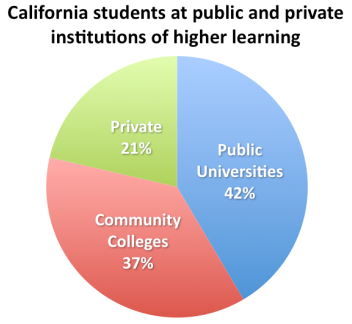Take our public system private?
California has the largest system of public-supported higher education in the world. California Community Colleges, State Universities and the 10-campus University of California are educating more than 1.2 million undergraduate, graduate and professional degree students.
In recent years, Governor’s Arnold Schwarzenegger and Jerry Brown have reduced state support of public higher education and shifted the cost of core education programs onto students and their families through higher tuition. In the 2004 “Higher Education Compact” with Governor Schwarzenegger, UC and CSU agreed, “In order to help maintain quality and enhance academic and research programs, UC will continue to seek additional private resources and maximize other fund sources available to the University to support basic programs. CSU will do the same in order to enhance the quality of its academic programs.”
This policy is congruent with free-market philosophies that treat advanced education as solely a private good: since the student benefits from a college degree, the student or her family should borrow the money to pay for it.
Under a fully privatized model, tuition would need to reach $27,000 a year at the University of California to restore the quality education it offered in 2001 (calculation). With the massive increases in recent years, the Regents are well on their way to reaching this goal.
But greater student debt is not the only consequence of privatizing higher education. Top-quality private models such as Stanford and the University of Southern California simply cannot operate on the scale required to serve a population of 39 million Californians, so far fewer Californians will be able to earn college degrees if public universities are privatized.
• Universities on the private model cannot meet the growing need
From 2000 to 2008, the University of California’s undergraduate and graduate enrollment grew 30% to 207,000. Stanford University’s student body grew 1%, to 15,140.
• Higher education in California, public-private enrollment
Public institutions in California enroll 79% of all college and university students (full-time equivalents), including 76% of all 4-year undergraduates, and 39% of all graduate and professional students.
• Teachers, engineers and medical professionals earn public degrees
Public universities account for nearly 80% of undergraduate degrees. More than half of all California degrees in education and two-thirds in business, nursing, engineering and medicine are earned at public institutions.

Policy consequences for…
Access: A privatized system would not have the resources to meet the growing needs of California. Access would be much more heavily rationed.
Affordability: Tuition and credit-hour costs would skyrocket. Less student aid.
Excellence: Research and teaching would be shaped by special interests looking for a direct return on their training and research investments.
Accountability: Assets built up by generations of Californians would be in private hands, with little or no public oversight.
